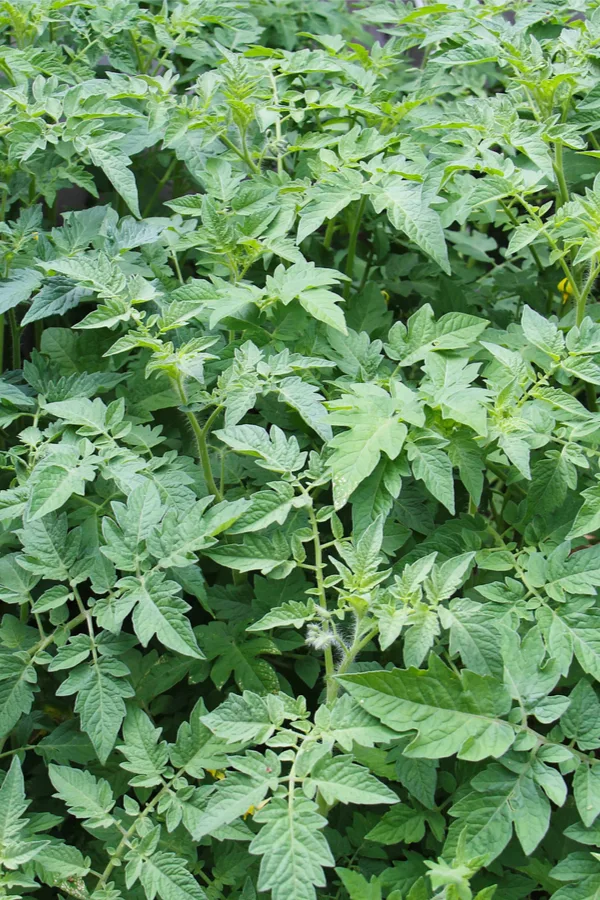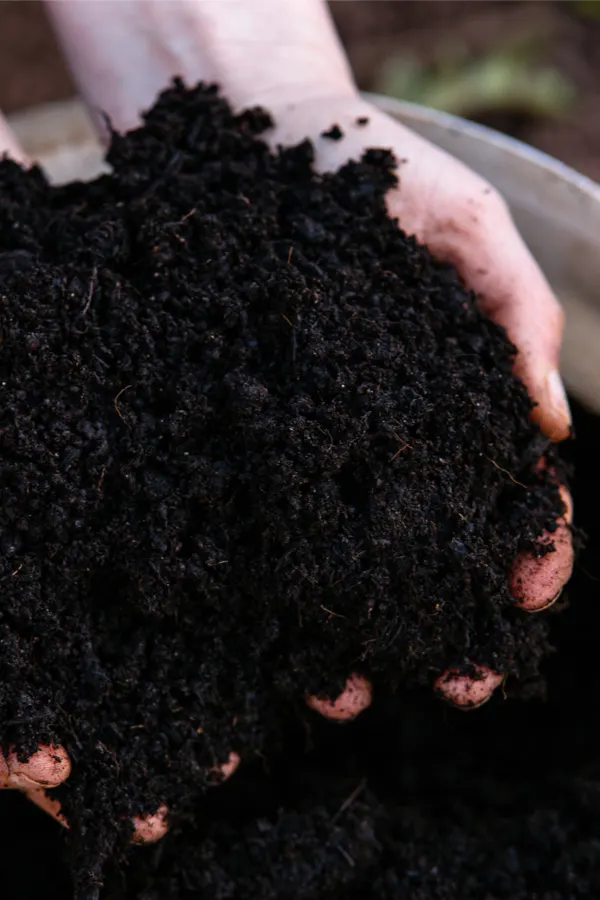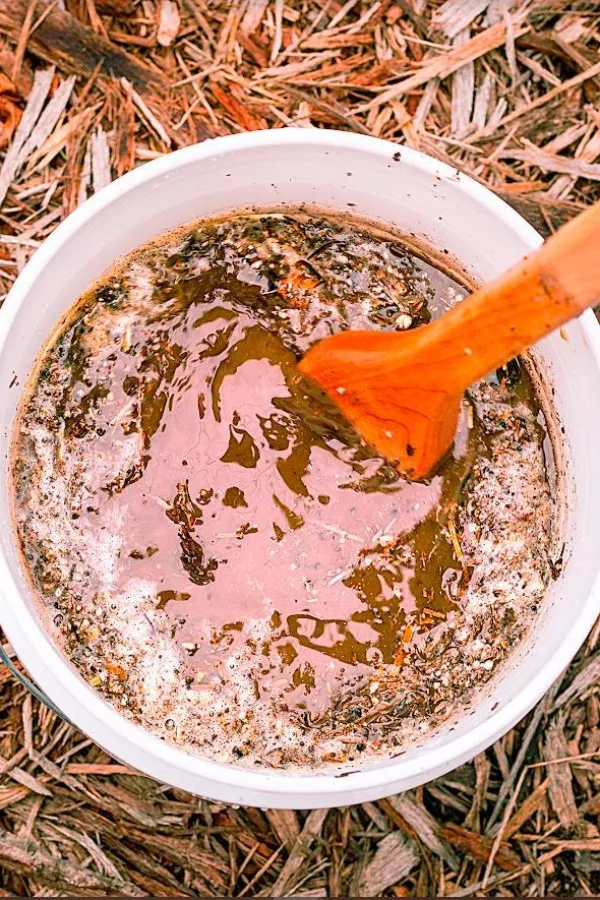When it comes to growing healthy, productive and delicious tomatoes in your garden naturally, there is no better way to power your tomato plants than to fertilize them with compost.
You simply can’t get more organic and natural than compost. Created from the remnants of once living plants and organic material, it is both safe and powerful. And can it ever invigorate plants – especially when it comes to the tomato plants growing in your garden!
The nutrients within compost are a perfect match for what tomatoes need to thrive. But even more, they are in a form that can easily absorb into the plants roots and foliage.

Why Tomatoes Need Fertilizer
Tomato plants require a tremendous amount of nutrients from the soil in order to grow healthy and strong. In addition to a tomato plant’s need for nitrogen, phosphorus and potassium, they also need calcium, magnesium and other minerals.
All of these important nutrients help to maintain healthy foliage, produce blooms and ripen fruit. Not just when they are seedlings and young plants, but as they begin to flower and fruit as well.
No matter how rich and fertile soil might be in early spring, it can lose its vitality during the season. As plants continue to draw and deplete resources from the soil, it becomes more difficult for them to find and locate the nutrients they need.
Unfortunately, when this happens, the plant begins to suffer. For starters, poor nutrient levels lead to less growth and fewer tomatoes for you to enjoy. In addition, a weak plant is also a prime target for pests and disease. And that is exactly why tomatoes need a boost of energy from time to time.
But here’s the catch, fertilizing tomatoes can be a tricky business. Fail to give them enough nutrients, and they struggle in some cases to even survive. But give them too much energy, or too much at once, and it can result in big trouble for the plants as well.

The Dangers of Over Fertilizing – How To Fertilize Tomatoes With Compost
When tomato plants receive too much fertilizer, they use all of that excess energy to promote growth. And lots of it! That might sound good on the surface, but that massive growth comes at the expense of setting flowers and fruit.
Quite often, a tomato plant that has too many nutrients will look beautiful at first glance. In fact, it can have massive growth, sturdy, thick stems, and deep green foliage. But unfortunately, if you look closer, you will see very few blooms or future tomatoes on the plant.
This is the direct result of too much fertilizer absorbing into the plant. Instead of using the excess nutrients to create more flowers and tomatoes, they use it to expand and grow. And while in that massive growing mode, the plant shuts down its flower and fruit production.
The good news is, with compost, over fertilizing is never an issue. The balanced nature of compost supplies the nutrients needed for strong, steady growth, without overpowering plants.

Even better, compost can be utilized quite easily in two distinct methods. And when used together, they supply your tomato plants with the energy they need, right when they need it most.
With that in mind, here is a look at how to use compost to energize your tomato plants this year with a simple one-two approach!
How To Fertilize Tomato Plants With Compost – The 1-2 Punch That Works!
Powering your tomato plants with compost couldn’t be easier. The nutrients within compost are easily and quickly absorbed by plants. And depending on how the compost is used, it can supply those nutrients to the roots, or through the leaves of the plants.
When first planting your tomatoes, compost should be liberally in the planting hole. Mixing in a 50/50 ratio of soil and compost into the planting hole is the perfect way to get your tomatoes off to a great start. (See: How To Best Plant Tomatoes!)
The compost helps to loosen the soil and conserve moisture for the expanding roots, all while leaching nutrients to power growth. But that is not where composts power ends for energizing plants.
Once planted, compost can then be used to supply nutrients using two simple methods – top dressing ( mulching), and compost tea. Together, they will supply nutrients at just the right time, and in just the right way.

As you will see below, top dressing will provide the low & slow nutrients tomato plants need for development. Meanwhile, compost tea can supply a more powerful but balanced punch of energy when your tomato plants need it most.
Top Dressing with Compost – How To Fertilize Tomato Plants With Compost
Once you plant your tomatoes it is extremely important to apply a thick layer of mulch. Mulch not only helps repel weeds, it also aids in conserving moisture and regulates the soil temperature.
But if you mulch with compost, you get all of those benefits and more! By using a layer of compost mulch a few inches thick and six to 12 inches around each plant, you can power plants too. Every time it rains or you water, the compost leaches nutrients right to the roots below.
It is the perfect slow and steady release of nutrients tomato plants need to grow strong. And as the plant continues to grow, you can add more compost around the plants base every month to continue the slow release boost.
Liquid Fertilizing With Compost Tea – How To Fertilize Plants With Compost
Top dressing your tomato plants with a thick coating of compost provides the slow, steady trickle of nutrients plants need to develop good roots and foliage. Meanwhile, compost tea can help to power up plants for blooming and tomato production!

Compost tea can be made by simply steeping water and compost in a 5 gallon bucket. By soaking in the water for a few days, the compost imparts its nutrients into the water. And is it ever powerful! (See: How To Make Compost Tea)
Compost tea is a quick and effective boost of energy for plants, especially during their first few months of growing. By watering your plants with the tea, they plants absorb the nutrients both through the foliage and root zones.
But with compost tea, the nutrients absorb fast. And together with the low and slow of top dressing, it is the perfect fertilizing combination. By the way, if you do not make your own compost, bagged compost will work for making tea. Product Link : Bagged Compost
How Often To Apply
As for how often you should apply compost tea to tomato plants, a good rule of thumb is every two to three weeks for the first few months after the plants have been planted outdoors. Then, as plants begin to produce, you can simply let the slow and low compost mulch take back over.
It truly is a one-two fertilizing combination that will work wonders for your tomato plants. And, best of all, it is 100% natural and organic. It really doesn’t get much better than that! Here is to fertilizing your tomato plants naturally this year with compost.
Follow Our Facebook Page For Great Gardening Tips And Advice! This Is My Garden Facebook Page
This Is My Garden is a garden website created by gardeners, for gardeners. Jim and Mary Competti have been writing gardening, DIY and recipe articles and books and speaking for over 15 years from their 46 acre Ohio farm. They publish three articles every week, 52 weeks a year. Sign up today to follow via email, or follow along!

